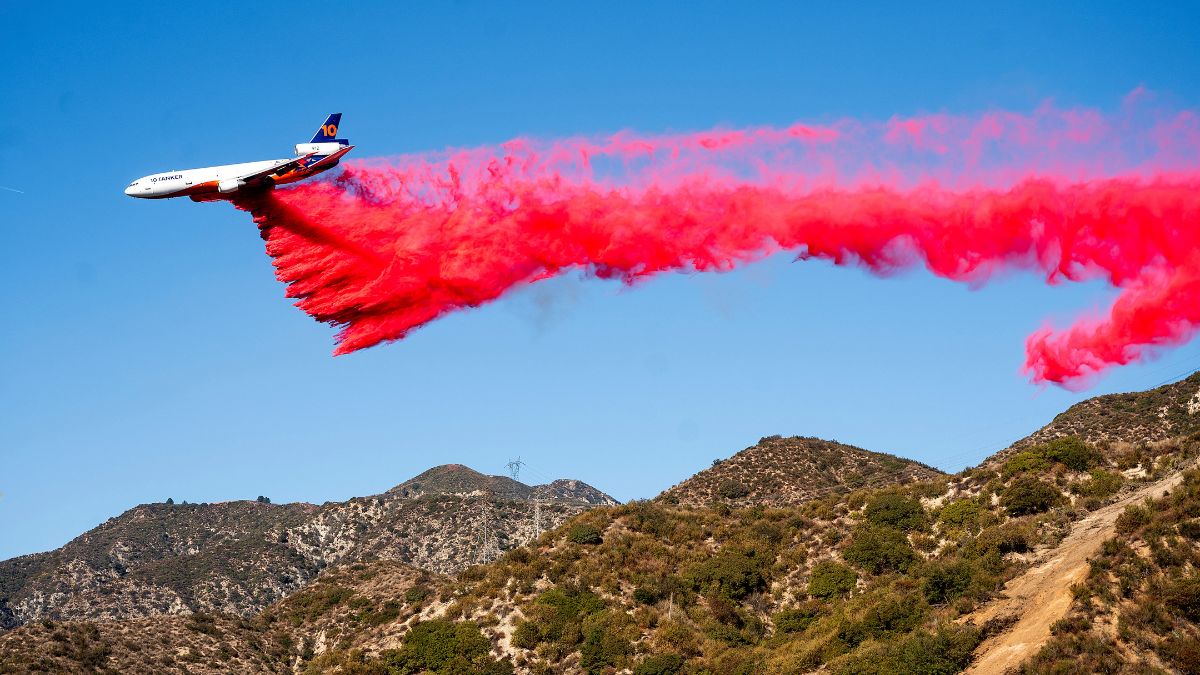As wildfires ravage southern California, the striking images of bright red and pink powder being dropped from air tankers have captured public attention.
This powder, a fire retardant called Phos-Chek, plays a critical role in combating the relentless flames.
But what exactly is it made of, how does it work, and is it safe?
What is Phos-Chek and how does it work?
Phos-Chek, a fire retardant developed by the company Perimeter, has been a key tool in wildfire suppression since its introduction in 1963. Originally formulated to help firefighters combat large-scale blazes, its effectiveness quickly garnered global recognition.
Today, it is the most widely used fire retardant worldwide, aiding firefighting efforts in regions prone to wildfires across North America, Australia, and Europe.
It is the primary fire retardant used by the California Department of Forestry and Fire Protection and remains the most widely used retardant globally, according to a 2022 Associated Press report.
The substance is composed of 80 per cent water, 14 per cent fertilizer-like salts, and 6 per cent colouring agents and corrosion inhibitors. Its red and pink hues act as visual aids for pilots and firefighters to identify treated areas, although the colour fades after a few days of sunlight exposure.
When dropped, Phos-Chek coats vegetation and fire-prone land to slow the fire’s spread. It works by cooling and coating fuels, depleting oxygen, and altering how plant materials burn.
“They don’t tend to drop [retardant] directly in the center of an ongoing fire,” Daniel McCurry, an associate professor of civil and environmental engineering at the University of Southern California told NPR.
“They tend to drop kind of at the barrier of it because they’re trying to prevent it from spreading. And the reason that these products are kind of useful for that potentially is that the active ingredient is not water. Right? It’s the fertilizer. So even after the water evaporates, you still have that red stripe there for days or weeks.”
Is it safe for the environment?
While Phos-Chek is vital in wildfire mitigation, its use has sparked environmental debates. Critics argue that its deployment, particularly near waterways, can lead to contamination harmful to aquatic ecosystems.
For instance, concerns were raised after a 2022 lawsuit highlighted potential violations of clean water laws by the US Forest Service. Environmental groups pointed to studies suggesting that certain formulations could harm fish and other wildlife.
On the other hand, supporters, including communities affected by wildfires, highlight its crucial role in preventing catastrophic destruction, with some citing past incidents where the retardant effectively safeguarded homes and lives.
The Forest Service enforces a mandatory ban on dropping fire retardants in sensitive areas, such as waterways and habitats of endangered species, except when human life or public safety is at risk. These measures aim to mitigate potential harm to aquatic life and ecosystems.
In 2022, the Forest Service Employees for Environmental Ethics filed a lawsuit, claiming the agency violated clean water laws by using chemical retardants. A federal judge later ruled that the practice could continue while the Forest Service seeks a permit from the Environmental Protection Agency.
In response to environmental concerns, the Forest Service has transitioned to a newer Phos-Chek formula, MVP-Fx, which studies suggest is less toxic to aquatic life than the older LC95 formulation.
“MVP is one of our latest technologies and is made with technical and food-grade ingredients,” Perimeter told NPR. The company states that its products meet stringent safety standards, including California’s Proposition 65 requirements.
How do pilots navigate with Phos-Chek?
Despite its effectiveness, deploying Phos-Chek involves significant risks. Pilots guiding air tankers are tasked with navigating low-altitude flights over rugged terrain, often in poor visibility and turbulent conditions caused by the fire itself.
These challenges increase the likelihood of accidents, and tragically, the job has claimed lives. From 2000 to 2013 alone, wildfire aviation accounted for 78 fatalities in the United States, according to the Centers for Disease Control and Prevention.
How to remove it after?
The vibrant pink residue left by Phos-Chek can coat vehicles, rooftops, and driveways in affected areas, often leaving residents with an unexpected cleanup task.
Perimeter advises cleaning it as soon as it is safe to do so, as the substance becomes harder to remove once dried. Warm water and mild detergents are effective for smaller surfaces, while pressure washers are recommended for larger areas.
With inputs from agencies
)